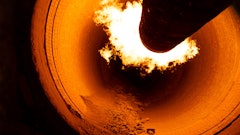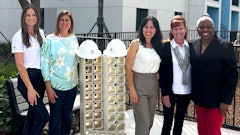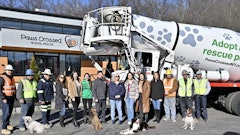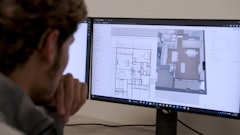
Heat from inside the earth can be used as an efficient energy source to heat and cool commercial properties through ground source heat pumps (GSHPs). These pumps are electrically powered systems that tap the earth’s stored energy. They use the earth’s relatively constant temperature to provide heating, cooling and hot water for commercial buildings.
Ground source heat pumps can be categorized as having closed or open loops, and those loops can be installed in three ways: horizontally, vertically or in a pond/lake.
As a part of a geothermal heating/cooling system, GSHPs work on a different principle than an ordinary furnace/air-conditioning systems. Furnaces in a typical heating system create heat by burning a fuel (typically natural gas, propane or fuel oil). With geothermal systems, there’s no need to create heat and no need for chemical combustion.
Instead, the earth’s natural heat is collected through a series of pipes, called a loop, installed below the surface of the ground or submersed in a pond or lake. Fluid circulating in the loop carries this heat to the building or structure.
A geothermal unit, installed inside the building, uses electrically driven compressors and heat exchangers in a vapor compression cycle (the same principle as employed in a refrigerator) to concentrate the earth’s energy and release it inside the building at a higher temperature. In typical systems, duct fans distribute the heat to various rooms.
“The most simplistic way to think of a geothermal system is that it does two things: pumps water and blows air,” says John Freitag, Executive Director, Geothermal Alliance of Illinois.
In the simplest use of ground-source heating and cooling, a tube runs from the outside air, under the ground, and into the building’s ventilation system. More complicated, but more effective, systems use compressors and pumps — as in electric air-conditioning systems — to maximize the heat transfer.
“A geothermal system pumps water from ground [or through a continuous closed-loop system]. Fluid is circulated throughout the system and during the heating season, heat is extracted for use in the building and the fluid is pumped back through the system. The fluid is pumped back into the system colder than it came in. As the fluid transfers through the closed-loop system, it builds heat which is ready to be extracted out by the time it circulates around again,” explains Freitag.
In summer, the process is reversed. Excess heat is drawn from the building, expelled to the loop and absorbed by the earth. Geothermal systems provide cooling in the same way that a refrigerator keeps its contents cool — by drawing heat from the interior, not by injecting cold air.
A loop installer’s perspective
Durbin Geothermal in Beecher City, Illinois, is a family-owned company.
“We got our start in ground source geothermal loop installation in 2000 when my dad, our company’s founder Sam Durbin, was building his own home,” says current owner Dom Durbin. “He was told there was a six-month backlog before a loop could be drilled, so we decided to do it ourselves. We were already doing dozing and excavating so we bought a drill rig and got started.”
Durbin Enterprises Inc. was a successful trucking and excavating business with many of the machines and tools necessary to install geothermal loops. Durbin Sr.’s home was near a small, relatively shallow oil patch in central Illinois. He bought an older Failings 1500 Holemaster drilling rig then hired a local man with drilling experience as well as his two sons, Dom and Robert.
“It’s a specialized industry so we reached out to geothermal HVAC equipment manufacturers to teach us how to combine our knowledge of dirt and excavating with their methods of transferring heat with the earth,” says Dom.
Today Durbin Geothermal is a respected geothermal system installer throughout the Midwest. “Geothermal is now 95% of what we do,” says Dom. “And we currently have seven vertical drilling units, one horizontal directional drilling unit, several excavators and trenchers, as well as a full complement of support trucks and tools.”
The past 12 years have been a learning curve for Dom and his family on diversified loop installation methods and site construction needs. And in those 12 years, geothermal installations have become more popular. “There are now enough case studies and enough tests have been done that more engineers and contractors are more comfortable with geothermal systems,” he notes.
Dom credits communication as a key to any project’s success.
“Everything you change and modify on a geothermal installation has an impact on another piece of the installation,” he stresses. “If you just tried to divide work from inside the structure [mechanical contractor] and outside the structure [excavating/drilling contractor] ... if either make changes to anything [piping/depth/unit sizes/building envelope/building load] it has an impact on other sides. Communication and working with other trades is critical to the success of a geothermal installation.”
The future of geothermal
“Building operators are extremely concerned with energy costs, now and in the future,” explains Freitag. In addition to being an environmentally friendly heating/cooling option, geothermal systems are providing cost savings for those who install them.
According to Freitag, geothermal energy has the potential to play a significant role in moving the United States (and other regions of the world) toward a cleaner, more sustainable energy system. Geothermal energy is one of the few renewable energy technologies that — like fossil fuels — can supply continuous, baseload power.

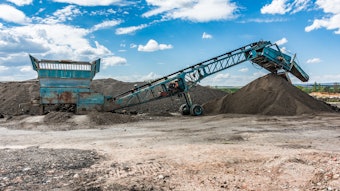
![Img 1707[56]](https://img.forconstructionpros.com/files/base/acbm/fcp/image/2023/04/IMG_1707_56_.6437076c97961.png?auto=format%2Ccompress&fit=crop&h=191&q=70&rect=0%2C462%2C1920%2C1080&w=340)









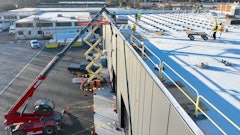
![Glp Porsche 072723 465 64ee42287c29e[1]](https://img.forconstructionpros.com/files/base/acbm/fcp/image/2024/03/GLP_PORSCHE_072723_465.64ee42287c29e_1_.65e88b8589b9c.png?auto=format%2Ccompress&fit=crop&h=135&q=70&rect=0%2C520%2C2250%2C1266&w=240)

